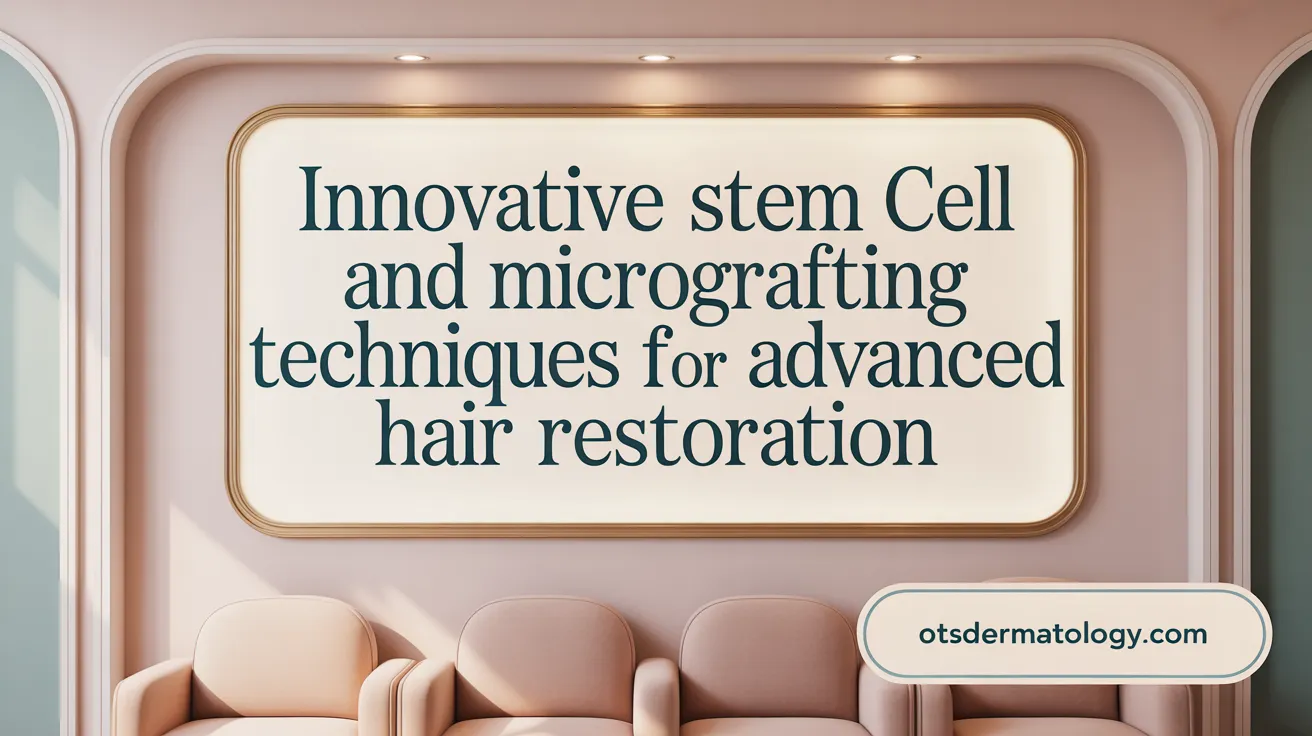Introduction to Modern Hair Restoration
Hair Loss Prevalence and Impact
Hair loss, particularly androgenetic alopecia, is a widespread condition affecting up to 80% of white men and 40% of women before the age of 70. This chronic condition can significantly affect self-esteem and quality of life. Common forms such as male pattern baldness are mainly influenced by genetics and hormones.
Overview of Hair Restoration Techniques
Traditional hair restoration methods include prescription medications like finasteride and minoxidil, as well as surgical interventions such as follicular unit transplantation and hair transplantation using FUE techniques.
Focus on Platelet-Rich Plasma (PRP) and Emerging Therapies
Emerging treatments have introduced biologic approaches like platelet-rich plasma (PRP) injections and stem cell therapies. PRP involves concentrating the patient's own platelets and growth factors to stimulate scalp blood flow and hair follicle regeneration. It acts by promoting cell proliferation, neo-angiogenesis, and hair follicle cycling.
Additionally, low-level laser therapy (LLLT) and mesenchymal stem cell micrografts represent promising adjunct or alternative therapies to improve hair density and regrowth. These advanced options emphasize personalized, minimally invasive care aimed at restoring natural hair growth with fewer side effects.
Understanding Androgenetic Alopecia and Traditional Treatments

What is Androgenetic Alopecia and How Common Is It?
Androgenetic alopecia (AGA), also known as male or female pattern hair loss, is a chronic condition characterized by progressive hair thinning primarily due to genetic and hormonal factors. It affects approximately 80% of white men and 40% of women before the age of 70. In men, the condition is linked to the hormone dihydrotestosterone (DHT) causing miniaturization of hair follicles, while women may experience diffuse thinning influenced by hormones, pregnancy, menopause, or thyroid disorders. For more on Androgenetic alopecia treatments and Causes of Hair Loss, see these resources.
What Are the Standard Treatments for Androgenetic Alopecia?
Current conventional treatment options include:
- Finasteride: An oral prescription medication that inhibits DHT production to slow hair loss and promote regrowth.
- Minoxidil: A topical, over-the-counter treatment that helps stimulate hair follicles and increase hair density.
- Hair Transplantation: Surgical techniques such as Follicular Unit Extraction (FUE) or Follicular Unit Transplantation (FUT) that relocate follicular units from dense to thinning areas.
These treatments primarily aim to preserve existing hair or restore hair in localized areas with varying success rates. More about Hair Transplantation Experts and Hair Restoration Treatments in Glenview, Illinois can be found here.
Why Are New Treatments Being Developed?
Limitations of traditional therapies include variable efficacy, the necessity for lifelong use, side effects, and incomplete restoration—leading to patient dissatisfaction. Additionally, hair transplantation, though effective for balding spots, is invasive and limited by donor hair availability.
Consequently, novel biotechnologies such as platelet-rich plasma (PRP) therapy and stem cell treatments are emerging to address these gaps by promoting natural hair follicle regeneration and enhancing scalp health, offering promising complementary or alternative solutions.
These advancements target stimulating hair follicle stem cells, improving microcirculation, and leveraging growth factors in PRP to rejuvenate hair follicles, thus expanding hair restoration options beyond conventional methods. For detailed insights on PRP preparation protocols and clinical efficacy of PRP treatments, consult these sources.
Platelet-Rich Plasma (PRP): Mechanism and Clinical Evidence for Hair Regrowth

How is PRP prepared and administered for hair regrowth?
PRP treatment begins by drawing a small sample of the patient's blood, which is then centrifuged to concentrate platelets into plasma. This platelet-rich plasma is typically prepared to reach about 5.8 times the platelet concentration of whole blood, averaging around 1.5 million platelets per microliter—the optimal level for stimulating angiogenesis in hair follicles. The prepared PRP is injected into the scalp at precise depths of 1.5 to 2.5 mm, delivering approximately 0.1 mL per cm². Treatment sessions usually involve multiple injections spaced across a series of 3 to 4 sessions at monthly intervals, with maintenance treatments every few months recommended to sustain benefits. For detailed protocols on PRP preparation protocols and centrigation concentration, see resources on PRP preparation and centrifugation protocol and PRP preparation protocols.
What growth factors in PRP help promote hair follicle regeneration?
PRP contains a rich mixture of growth factors including basic fibroblast growth factor (bFGF), platelet-derived growth factor (PDGF), vascular endothelial growth factor (VEGF), epidermal growth factor (EGF), transforming growth factor-beta (TGF-β, and insulin-like growth factor-1 (IGF-1. These factors collectively stimulate cell proliferation, differentiation, and neo-angiogenesis—key biological events essential for hair follicle regeneration. They enhance keratinocyte and bulge stem cell activity, increase local blood vessel formation, and support the cycling of hair follicles from dormant to active growth phases. Learn more about the growth factors in PRP and the role of hair follicle stem cells as well as Growth factors in PRP.
What results have clinical studies demonstrated regarding hair density and follicle activity?
Clinical evidence supports PRP’s effectiveness in promoting hair regrowth and increasing hair density. A randomized, placebo-controlled study found a mean increase of 33.6 hairs and an increase of 45.9 hairs/cm² in total hair density following three PRP sessions. Histological evaluations have shown increased epidermis thickness, higher numbers of hair follicles, and greater proliferation of hair follicle cells. Additionally, increased vascularization surrounding hair follicles fosters a healthier scalp environment conducive to sustained hair growth. For a summary of clinical efficacy of PRP treatments, and PRP injection results on hair density, see these resources.
What is the safety profile and common side effects of PRP treatment?
PRP therapy is considered low-risk since it uses autologous blood components, minimizing risks of allergic reactions or rejection. Commonly reported side effects are mild and temporary, including localized soreness, bruising, or slight discomfort at injection sites. No major adverse events have been reported in clinical trials, marking PRP as a safe option for patients seeking non-surgical hair restoration treatments. For more on PRP treatment safety and side effects and PRP injection side effects, consult these references.
Emerging Biotechnologies: Stem Cell Therapies and Micrografting

Role of hair follicle stem cells and Wnt/β-catenin signaling in hair regeneration
Hair follicle stem cells, located primarily in the bulge region, include epithelial, melanocytic, and multipotent stem cells, which exhibit remarkable plasticity of hair follicle stem cells and potential for hair regeneration. These stem cells are critical in the natural hair follicle cycling process, contributing to hair follicle development and repair.
A fundamental molecular pathway involved in this regeneration is Wnt/β-catenin signaling in hair follicles. Enhanced activity of Wnt signaling within dermal papilla cells (DPCs) stimulates proliferation and differentiation necessary for new hair growth. This signaling pathway promotes follicular cycling and is a core element in advancing hair regeneration therapies.
Experimental approaches including mesenchymal stem cell micrografts
Innovative experimental treatments are currently focusing on improving hair regrowth by leveraging hair follicle mesenchymal stem cell micrografts. These micrografts involve harvesting stem cells from hair follicles and enriching them to promote neogenic hair follicle production using micrografts. By mimicking embryonic developmental stages through cell culture techniques, these approaches aim to regenerate hair follicles in previously bald scalp areas.
Such micrografting utilizes cells with regenerative potential to stimulate angiogenesis and follicular renewal, potentially offering a novel, minimally invasive alternative or complement to existing treatments.
Potential and current limitations of stem cell based hair regrowth
Despite promising laboratory and early clinical results, stem cell-based hair regrowth therapies remain mostly experimental and not yet widely available. Challenges include identifying optimal cell types, ensuring consistent cell viability and function, and developing standardized PRP preparation protocols for clinical use.
Current limitations also include the need for more extensive clinical trials to confirm long-term safety and effectiveness. While stem cell therapies could revolutionize treatment for androgenetic alopecia treatments and other hair loss disorders, further research and regulatory approvals are required before these techniques can become routine clinical practice.
Enhancing Outcomes: Combination Therapies and Technological Innovations

How does low-level laser therapy (LLLT) enhance PRP and stem cell treatments?
Low-level laser therapy (LLLT) is emerging as a valuable adjunct to PRP and stem cell therapies in hair restoration. By using red light to stimulate blood circulation in the scalp, LLLT enhances cellular metabolism and promotes hair follicle activity. Patients receiving LLLT after PRP or stem cell injections tend to experience improved hair density and growth rates. This combined approach boosts scalp health and accelerates the regenerative benefits of growth factors released by both platelet-rich plasma and stem cells.
How is PRP integrated with surgical hair transplantation techniques?
PRP is frequently combined with hair transplantation to optimize follicle survival and the overall restoration outcome. Injecting PRP into the scalp during or after procedures such as Follicular Unit Extraction (FUE) or Follicular Unit Transplantation (FUT) promotes angiogenesis and accelerates wound healing. These growth factors support transplanted follicles, reduce operative downtime, and may lead to thicker, stronger hair growth. Clinics often recommend a series of PRP treatments before and after surgery for enhanced and sustained results.
How do robotic and advanced FUE methods improve surgical hair restoration?
Robotic FUE systems, such as the ARTAS Robotic System, represent a significant technological advancement. These systems provide high precision in harvesting follicular units, minimizing scarring and ensuring consistent graft quality. Additionally, advanced manual techniques like the Advanced FUE® and No-Shave FUE™ offer natural-looking results with lifetime growth guarantees. These methods, supported by experienced surgeons, enhance patient satisfaction by reducing invasiveness and improving aesthetic outcomes.
What are recommended maintenance protocols and how do they affect patient satisfaction?
Maintenance is critical in preserving hair regrowth achieved through PRP, stem cell therapies, or transplantation. Typically, patients undergo a series of three to four initial treatments spaced about a month apart, followed by maintenance sessions every 3 to 12 months. This schedule helps sustain hair follicle stimulation and scalp health. Satisfaction levels remain high when treatments are personalized, combining non-invasive therapies and surgical options, ultimately resulting in thicker, healthier hair and renewed confidence.
Personalized Care at Dermatology Practices: Local Expertise and Patient-Centered Options
Role of Dermatology Clinics in Glenview, Illinois, Offering PRP and Advanced Hair Restoration
Dermatology clinics in Glenview, Illinois, such as Front Range Dermatology, California Skin Institute, and Schweiger Dermatology Group, provide a range of advanced hair restoration treatments. These facilities offer both platelet-rich plasma (PRP) therapies and surgical options including Follicular Unit Extraction (FUE) and robotic hair transplantation such as the ARTAS Robotic System. The expertise available locally ensures patients have access to cutting-edge technology combined with experienced care.
Customized Treatment Plans Based on Individual Hair Loss Causes and Stages
Each patient's hair loss pattern and underlying causes—ranging from androgenetic alopecia to hormonal or stress-related thinning—are carefully evaluated to tailor treatment approaches. Clinics utilize diagnostic assessments to determine the severity and type of hair loss, enabling a comprehensive plan that might integrate PRP, low-level laser therapy (LLLT), medication, or surgical interventions according to individual needs. These plans often incorporate PRP preparation protocols and the role of growth factors in PRP for stimulating inactive hair follicles effectively.
Importance of Consultation and Managing Patient Expectations
Consultation sessions play a crucial role in educating patients about the benefits and limitations of each therapy. Dermatologists emphasize realistic outcomes and the gradual nature of hair regrowth with PRP and other treatments. This transparent communication helps patients understand that results vary based on personal factors and that multiple sessions are often necessary. Understanding how PRP injections work and possible side effects of PRP therapy enhances patient confidence.
Long-Term Care and Maintenance Recommendations
Sustained success in hair restoration often requires ongoing care. Maintenance treatments, such as follow-up PRP injections every 4-6 months or yearly and continued use of topical or oral medications when indicated, are recommended to preserve results. These clinics also monitor progress regularly to adjust treatment plans, ensuring a patient-centered approach to long-term hair health. Incorporating PRP preparation protocols and understanding optimal platelet concentration for angiogenesis help maintain effective treatment outcomes.
Future Outlook in Hair Restoration
Advances in PRP and Stem Cell Therapies
Recent innovations highlight platelet-rich plasma (PRP) and stem cell therapies as promising avenues for hair regeneration. These treatments utilize growth factors and stem cells to stimulate cell proliferation, improve follicle health, and enhance hair cycling, offering more natural, less invasive solutions.
Continuing Research and Personalized Care
Ongoing clinical studies focus on optimizing PRP preparation and combining therapies, such as low-level laser therapy and stem cell injections. Personalized treatment plans tailored to individual patient profiles are key to improving outcomes and long-term benefits.
Emerging Hope
These biotechnologies provide hope for effective hair regrowth methods that reduce dependence on medications and surgical procedures. With advances in understanding follicle biology and regenerative medicine, the future promises safer, more sustainable hair restoration options.
